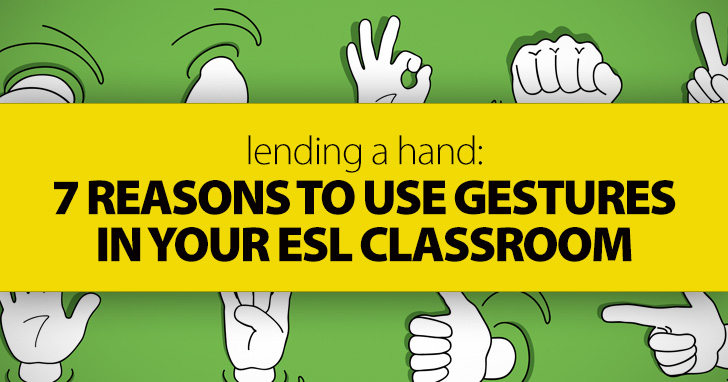Rinse and Repeat: 4 Ways to Establish Great ESL Classroom Routines


A statuesque public speaker might inspire us with his content, but we also seek a visual engagement, a sense that the points are being delivered through a the voice but also through the body. Such non-verbal communication certainly involves the face, and I believe the hands make an essential contribution also, both to the meaning and clarity of what’s being said, and to the overall experience of observing the speaker.
Before we continue, here’s a little exercise to get you thinking about gesture. Consider how you might teach these words by using only very simple English but with the help of your hands. Below, we’ll see how some experienced teachers tackled the same questions:
Conflict Volcano Strength Exhaustion Pendulum
When teaching, our hands become learning aids of great flexibility and importance. Some cultures emphasize the use of the hands more than others; I believe that the usefulness of gesture as a teaching tool can transcend cultural boundaries. After all, most of the gestures a good teacher might use are understood by everyone, not only those from their own culture. For new teachers, especially, using gesture has a myriad advantages.

A single well-considered gesture can do the work of a dozen explanatory words. Try teaching ‘together’ or ‘separate’ without using your hands!
At their best, classroom gestures are an ancillary, supportive measure. They are communicated alongside language, rather than replacing it entirely, to clarify and illuminate what is being said
Organizing classroom activities, managing the flow of a discussion, dealing with discipline issues and communicating instructions are all made far easier with the use of your hands. All the way from, “Open your books, please,” to “Divide into groups of four and head into the corners of the room,” gestures clarify your meaning and quicken the student response. They resolve confusion and give everyone directions they can understand.
From Lapland to Mongolia to Fiji, giving someone two thumbs up is recognized in precisely the same way. Consider that family of universal gestures - stop, continue, please, thank you, I’m sorry, I love you. There isn’t a grown person alive in the world who does not understand the basic message of each one.
I can’t imagine teaching any kind of class without using my hands, but working with beginners in the absence of gestures would be (very literally!) like teaching with my hands tied behind my back. Your hands give you shapes and sizes, numbers and amounts, days and months, opposites and parallels, increases and decreases, stops and starts…
When teaching in China, I noticed that most of my trainees kept their hands by their sides. I wasn’t about to try to introduce a huge, new cultural tradition, but I recognized that a marvelous teaching tool was being under-utilized. So, I encouraged my students to learn and practice a family of simple gestures. They found them useful, despite the prevailing cultural differences, and these simple routines have helped a lot in their own teaching.
There is little you might ever want to communicate to an ESL class which won’t benefit from being accompanied by a gesture.
One of the most useful areas is in error correction:
There are many other useful types of gesture - too many to list - but these are some of the most common:
Gestures can (and probably should) play a role in the presentation of virtually every word you ever teach. Remember the five words we considered above? Here’s how some veterans used gesture to get those meanings across:
| Conflict: | Tight fists bumped together at the knuckle; worried or angry face |
| Volcano: | Following the shield shape with hands approaching each other, then a spread-finger explosion to signify the lava, accompanied by a surprised/shocked facial expression (and perhaps even a sound) |
| Strength: | ‘Popeye’ gesture, bulging biceps, clenched fists, sturdy posture, fist smacking into open palm |
| Exhaustion: | Slumped shoulders, sighing, bent back, trudging steps, mopping the brow |
| Pendulum: | Downward-pointing finger which swings left to right in a slow, regular rhythm, watched by the teacher’s eyes |
The more you practice and try new things, the more gestures will be added to your armory. I firmly believe that using your hands in the classroom will benefit your students and help you to provide clearer, more vivid and more memorable explanations.